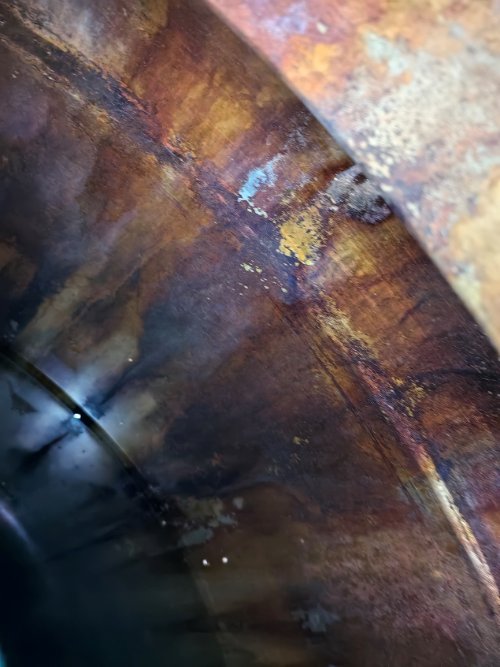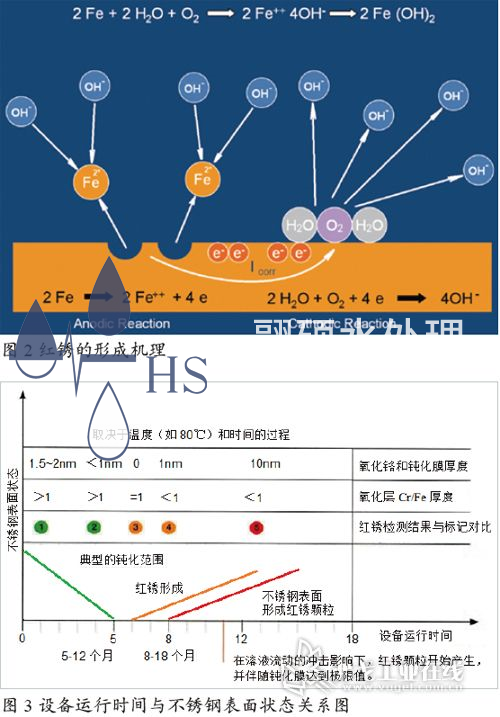إزالة الصدأ الأحمر الأنابيب
تكنولوجيا جديدة لمنع الصدأ الأحمر وإزالته ، والدور المتميز لمكافئ HS-210 في إزالة الصدأ الأحمر وتشغيله ، وتدابير الصيانة لأنظمة المياه الصيدلانية بعد حدوث الصدأ الأحمر.
أحد الأسباب الرئيسية لاستخدام الفولاذ المقاوم للصدأ في هندسة الأدوية هو مقاومته المتفوقة للتآكل. عندما تظهر بقع الصدأ البنية الحمراء على سطح الفولاذ المقاوم للصدأ ، غالباً ما يعتقد الناس: "الفولاذ المقاوم للصدأ لا يصدأ ، وإذا صدأ ، فهو ليس الفولاذ المقاوم للصدأ بعد الآن. يجب أن يكون مشكلة مع الفولاذ. في الواقع ، هذه هي وجهة نظر خاطئة ومحاصرة للفولاذ المقاوم للصدأ. في الواقع ، يمكن للفولاذ المقاوم للصدأ أيضًا أن يصدأ في ظروف محددة ، والتي تسمى "ظاهرة الصدأ الأحمر" في الهندسة ، كما هو مبين في الشكل 1.

الصدأ الأحمر هو ظاهرة هندسية شائعة لمواد الفولاذ المقاوم للصدأ في أنظمة عملية السوائل الصيدلانية. غالبا ما يحدث الصدأ الأحمر على الجدران الداخلية لغرفة مضخة النقل ، وجسم صمام الحجاب الحاجز والحجاب الحاجز ، وجسم الخزان ، والجدار الداخلي لكرة الرش ، واللحام من الفولاذ المقاوم للصدأ والمناطق المتأثرة بالحرارة في المياه الصيدلانية وأنظمة عملية السوائل الأخرى. عند مسح الجدار الداخلي من الفولاذ المقاوم للصدأ بقماش أبيض أو تصفية وعينات في منفذ نقطة المياه ، غالبا ما تظهر جزيئات صلبة صفراء أو حمراء ، والتي تتكون أساسا من الصدأ الأحمر من أكسيد الحديد.
هناك العديد من العوامل التي يمكن أن تسبب الصدأ الأحمر ، مثل بيئات درجات الحرارة العالية أو الضغط العالي. بيئات شديدة التآكل مثل الكلوريدات؛ مكونات الفولاذ المقاوم للصدأ غير؛ يمكن أن تؤدي إعداد السطح غير الصحيح (مثل مشاكل جودة اللحام ، وعيوب سطح المواد ، والتنظيف غير الصحيح أو التسلبي ، إلخ) أيضًا إلى تشكيل الصدأ الأحمر.
الضرر الناجم عن الصدأ الأحمر كبير. ينتمي إلى تلوث الجسيمات ويمكن أن يؤثر على نوعية المياه الصيدلانية ووضوح الأدوية. زيادة عبء العمل الفعال للمرشح ؛ يؤثر على مقاومة الضغط ومقاومة التآكل لأنظمة الفولاذ المقاوم للصدأ. قد يسبب تفاعلات فسيولوجية مع المنتج النهائي.
آلية تشكيل وتصنيف الصدأ الأحمر
الأكسدة هي شكل شائع من أشكال التفاعل الكهروكيميائي، ومبدأه الرئيسي هو أن عنصر واحد يطلق الإلكترونات بينما يمتص عنصر آخر الإلكترونات، مما يشكل تفاعل تخفيض الأكسدة. في هذه العملية، يجمع الأكسجين مع عنصر معين في معدن أو سبيكة لتشكيل أكسيد معدن. الخصائص الأساسية لمقاومة التآكل من الفولاذ المقاوم للصدأ هي أن عنصر Cr في سبيكة يمكن أن تشكل فيلم أكسيد غني بالكروم مستقر على سطحه عند الاتصال بالأكسجين. ويتشكل على الفور في وجود غاز الأكسدة في الفولاذ المقاوم للصدأ. بعد تشكيل طبقة التنشيط ، يمكن تحسين مقاومة التآكل للمعادن ، ويظهر المعدن "الخمول" الفريد ، وسيتم تقليل معدل أكسدته إلى نطاق غير قابل للتهميل.
التآكل هو تفاعل كيميائي أو كهروكيميائي بين المعدن وبيئته، والذي يمكن أن يسبب تغييرات غير متوقعة في خصائص المعدن. هذه التفاعلات يمكن أن تؤدي إلى انخفاض في مقاومة التآكل للمعادن. تشمل الأنواع الشائعة من التآكل التآكل الموحد ، والتآكل الكهروكيميائي ، وتآكل الشقوق ، وتآكل الحفرة ، وتشقق التآكل الإجهاد ، والتآكل بين الحبيبات. بمجرد أن تتلف طبقة التنشيط من الفولاذ المقاوم للصدأ لسبب ما ، سيتفاعل الأكسجين في الماء ببطء مع عنصر Fe المفرج من المعدن لتشكيل أكسيد الحديد الفضيف ، وسيظهر سطح المعدن تآكل الصدأ ، المعروف باسم "الصدأ الأحمر". الشكل 2 هو آلية محاكاة لتشكيل الصدأ الأحمر. على الرغم من أن هذه الآلية لا تزال مثيرة للجدل ، إلا أنها توضح بشكل حيوي العملية الكيميائية لتشكيل الصدأ الأحمر.

الماء هو محلل كهربائي ضعيف للغاية. عند 25 درجة مئوية ، ثابت منتج الأيون كيلوواط من الماء هو 1 × 10-14. عند 100 درجة مئوية، ثابت منتج الأيون كيلوواط من الماء هو 55 × 10-14. تركيز [H +] و [OH -] في مياه الحقن عالية الحرارة أعلى بكثير من تركيز أنظمة المياه النقية بدرجة حرارة الغرفة ، مما يؤدي إلى زيادة في معدل التفاعل الكيميائي بين أيونات الحديد الحرة وأيونات الهيدروكسيد في الماء ، مما يؤدي في النهاية إلى توليد أكسيد الحديد وتسبب الصدأ الأحمر في النظام. لذلك ، فإن النظام أكثر عرضة للصدأ الأحمر عند التشغيل في ظروف درجات الحرارة العالية.
وفقًا لدرجة حدوثها ، يمكن تصنيف الصدأ الأحمر إلى ثلاثة أنواع: النوع الأول والنوع الثاني والنوع الثالث (الشكل 3). النوع الأول من الصدأ الأحمر، المعروف أيضًا باسم الصدأ الأحمر المهاجر، يحتوي على أكسيدات وهيدروكسيدات مشتقة من معادن مصدر مختلفة، مع Fe2O3 كمكون رئيسي وكمية صغيرة من FeO و Fe (OH) 2. النوع الأول من الصدأ الأحمر هو في شكل جسيمات ، مرتبطة بشكل فضفاض بسطح الفولاذ المقاوم للصدأ ، ويقدم لونًا أحمرًا برتقاليًا أو برتقاليًا ، مع ميل إلى الهجرة في المصب من نقطة تشكيل الصدأ الأحمر. النوع الأول من الصدأ الأحمر له خصائص التوليد السهل والإزالة السهلة وسهولة التكرار. النوع الثاني من الصدأ الأحمر ينتمي إلى التآكل النشط المتشكل محليا على الأسطح المعدنية ، ويتكون أساسا من Fe2O3 ، مما يقدم سلسلة من الكروماتوغرامات من الأحمر والبرتقالي والأزرق والأرجواني والرمادي إلى الأسود. الصدأ الأحمر من النوع الثاني يلتصق بقوة بسطح الفولاذ المقاوم للصدأ ويصعب إزالته بمجرد تشكيله. وغالبا ما يظهر في أشكال مختلفة مثل حفر التآكل وشقوق التآكل ، ويرتبط بتآكل الكلوريدات أو هاليدات أخرى.
الصدأ الأحمر من النوع الثالث هو أكسيد أسود ينتج بعد أكسدة التدفئة ، والتي غالبا ما تحدث على سطح بيئات درجات الحرارة العالية (مثل أنظمة البخار النقية). مكونها الرئيسي هو Fe3O4. مع سمك طبقة الصدأ الأحمر ، يتغير لون النظام من الذهب إلى الأزرق ، ثم إلى ظلال مختلفة من الأسود. تبدأ هذه الأكسدة السطحية في شكل فيلم مستقر وهي تقريبا غير حبيبية. بنيته البلورية تشبه بنيته المغناطيسية المستقرة للغاية.
كواشف إزالة الصدأ الأحمر ودراسات الحالة
كواشفات HS-220 و HS-210 هي عوامل تنظيف طورتها شركة Shuoke خصيصا لإزالة "الصدأ الأحمر" وتشغيل مواد الفولاذ المقاوم للصدأ. HS-220 هو عامل تنظيف قلوي يستخدم أساسا لإزالة بقع الزيت والشوائب البروتينية والأفلام الحيوية على سطح الفولاذ المقاوم للصدأ ، مما يوفر شرط أساسي لإزالة الصدأ وتأثير تنظيف HS-210 ؛ HS-210 هو عامل تنظيف حمضي ، مناسب بشكل خاص لمتطلبات خاصة في صناعات الأدوية ومستحضرات التجميل والأجهزة الطبية والأغذية والمشروبات. وتشمل مكوناتها الرئيسية حمض الفوسفوريك وحمض الستريك والمواد السطحية النشطة والمشتتتات ، والتي يمكن أن تزيل الصدأ الأحمر بشكل فعال على أسطح الفولاذ المقاوم للصدأ ، وخاصة الصدأ الأحمر من النوع الأول والنوع الثاني. ويبين الشكل 5 جدول مقارنة للذوبان في Fe2O3 بواسطة HS-210 بتركيزات مختلفة. قابلية الذوبان من Fe2O3 بنسبة 15٪ CIP يمكن أن تصل إلى 260g / 100 غالون.
المكون الرئيسي لمكافحة التنظيف CIP200 هو حمض الستريك ، والذي يتجنب بفعالية تفاعل التآكل الحمضي القوي على الفولاذ المقاوم للصدأ عند استخدام الأحماض القوية مثل حمض النيتريك للتنظيف وفقا للاتفاقية ؛ في نفس الوقت ، يحتوي كاشف التنظيف HS-210 على مواد سطحية نشطة ومشتتتات مستقرة ، والتي لا تزيد فقط من تأثير ترطيب السطح بل تقلل أيضًا من إعادة ترسب الأوساخ ؛ يمكن أن يكون عامل التنظيف HS-210 متوافقًا مع مجموعة متنوعة من المواد ، وهو في حالة رغوة منخفضة في أي درجة حرارة ، مما يمنع بشكل فعال تجويف مضخة الطرد المركزي. بالإضافة إلى ذلك ، يمكن شطفها بالكامل ، مع بقايا منخفضة جداً. من الأهمية الخاصة أن 15٪ CIP200 كواشف التنظيف لديه نفس تأثير التسلب مثل 17٪ HNO3 (الشكل 6) ، والتي يمكن أن تحقق إزالة خطوة واحدة من الصدأ الأحمر وتسلب التخليل في أنظمة الفولاذ المقاوم للصدأ، مما يبسط إلى حد كبير عملية التنظيف وتوفير وقت التنظيف. لذلك ، تم استخدام كواشف التنظيف HS-210 على نطاق واسع لإزالة الصدأ والتشغيل في أنظمة المياه النقية وأنظمة المياه الحقن وأنظمة البخار النقي وأنظمة إعداد السوائل وأنظمة CIP / SIP.
ملخص
للحد من خطر الصدأ الأحمر في أنظمة عملية السوائل الصيدلانية ، تحتاج الشركات إلى اعتماد مفهوم الإدارة "الجودة تأتي من التصميم" والتحكم بفعالية من مصدر التصميم. في الهندسة ، فإن التدابير التالية لها قيمة مرجعية معينة لمنع حدوث الصدأ الأحمر والسيطرة عليه:
تقليل درجة حرارة الدورة الدموية لنظام مياه الحقن بشكل مناسب ، مثل الحفاظ على درجة حرارة النظام بين 70 ℃ و 85 ℃ للتداول ؛
اتبع بدقة إجراءات التشغيل القياسية لحام لحام ، والتحكم بدقة في تركيب النظام وفقا لمبدأ الزوايا الميتة ثلاثية الأبعاد ، ومنع البقايا من التسبب في تآكل البلورات ؛
اختر جهاز رش موثوق به لمنع إدخال أيونات الحديد الخارجية الناجمة عن سقوط ملفات الحديد وتجنب الدوران الجاف والاحتكاك لكرة الرش.
ضمان تأثير التخلص الحمضي الجيد وتوليد فيلم التخلص بفعالية ، وإجراء التخلص الدوري للصيانة على النظام ، وتجديد فيلم التخلص ، وتوصي بدورة التخلص من 1-3 سنوات / وقت ؛
اختيار المواد الخام عالية الجودة لتركيب النظام ، وتتبع بشكل منهجي تقارير المواد من أنابيب الفولاذ المقاوم للصدأ والتجهيزات ، وضمان جودة ودرجة تلميع المواد 316L ؛
إدخال تقنية تحليل السوائل أو تقنية تحليل السطح للصدأ الأحمر ، وتركيب أجهزة المراقبة عبر الإنترنت للصدأ الأحمر ، وإنشاء آلية شاملة لتقييم المخاطر ، والكشف عنها وتنظيفها في وقت مبكر.